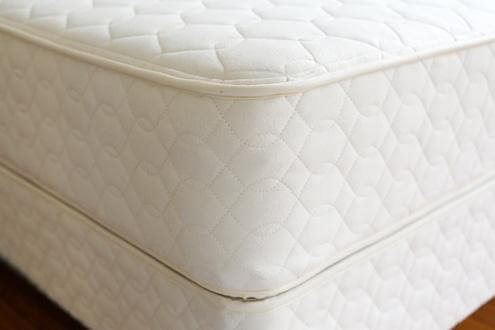Every purchase made online is encrypted with a high level of security you’ve come to expect. Your private information is never shared nor sold, so you can buy with confidence. You can also visit our store if you are in the St. Louis area.

Going Green
Who hasn’t heard about the big organic/green push in this day and age? At night, you retire to your cozy new mattress hoping for a long night of rest and rejuvenating bliss. However, while lying there in the dark you may have just entered into a technological synthetic nightmare. That’s right- have you ever considered what goes into the building of a mattress? Chemically sensitive people, allergy and even non-allergy suffers alike could be affected by their mattress and its component make up.
Mattress manufactures and the chemicals they use
The mattress industry has been accused of using Antimony Oxide (linked to cancer, liver, and heart damage) & Boric Acid (a dangerous pesticide to humans). The EPA associated Boric acid to sterility, fetal death, and birth defects, and it has been used to make mattresses fire retardant.
Flexible Polyurethane Foam (FPF) is chemically complex and found in virtually everything these days including the cushioning application of mattresses. Toluene diisocyanate (TDI) is one of the two primary reactants involved in the production of flexible polyurethane foams and has been a source of industry criticism in the past. Mattress ticking construction is often made up of chemically produced synthetic fibers like polyesters, or acrylics.
[optin-monster-shortcode id=”f3x7a5jv9mwo1oi8dqqh”]
Are all these materials safe and who is looking out for you?
In the case of food, the USDA Organic Seal protects consumers by assuring consumers that the spinach or milk they purchase measures up to certain standards and implements a fine up to $11,000 for each violation. Unlike bananas, tomatoes and spinach, mattresses have many different items that can go into the manufacturing process of that product. Each product should have to meet those same standards.
Today, no such guidelines are in place for the mattress industry standards concerning organic mattresses.
Confusing Terms
There has been a significant increase in organic-related options for the consumer. We have seen a mind-boggling number of additional choices that include Certified Organic Mattresses, and Natural Mattresses. Other terms such as Certified Organic Wool, Certified Organic Cotton have been introduced as well. We suggest you research before purchasing your next bed to get the facts straight about what is or is not in a truly organic Mattress.
The agricultural community admits that cotton is one of the leading industrial crops that requires the use of pesticides. The organic agricultural community can’t guarantee that their products are entirely free of chemical residues, yet the methods that are used claim to minimize pollutants from air, soil and water table. Animals are reared without the routine use of antibiotics and without the use of growth hormones which is one factor in the process of creating organic wool. Knowing these few simple facts could be enough to put at ease the minds of people who are concerned about the use of chemicals in mattresses. People can also rest assured that they are purchasing the most environmentally friendly mattresses industry experts claim.
Will the mattress industry go green and build their products using more of Earths renewable resources like, cotton, wool, and trees?
Only time or the dollars spent on them will tell.
